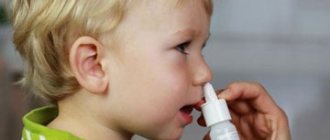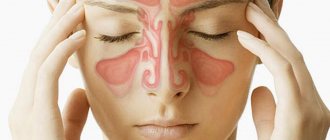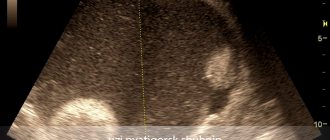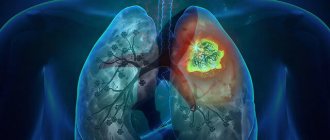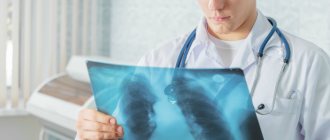What does the outcome depend on?
— Mikhail Petrovich, Nadezhda Olegovna, is there a worldwide problem of pulmonary fibrosis? Is this issue being discussed anywhere else besides Russia?
MK: The “frosted glass” effect (the manifestation of processes in the lungs in which a decrease in the density of lung tissue occurs - Ed.) was discovered by the Chinese. This means that we were not the first to begin to deal with the problem of pneumofibrosis - specific changes in the lung tissue that impair breathing after an illness.
NK: A lot of information comes from different countries that pulmonary fibrosis is reversible. Sometimes we see this in the clinic too. Of course, the patients are completely different, but we proceed from the damage to the lung tissue that occurred during the disease and what it resulted in later.
MK: There is a problem, but the disease has a favorable outcome, which depends on many factors.
— What is the danger of the disease and when is the outcome favorable?
MK : The outcome of pulmonary fibrosis may depend on the person’s age, the severity of the disease, timely prescribed treatment, the person’s immune system, his chronic pathology of the bronchopulmonary system, autoimmune diseases and other factors. Therefore, if we take a lung lesion of approximately 15% in a young person who is on his feet, and the same lesion in a person who is over 40 or 60 and who has a lot of other diseases, we will see different outcomes from each other. The reasons for the regression of the inflammatory process are also directly related to the human immune system and the treatment of pulmonary fibrosis, as well as further rehabilitation. This is a long process; it may not be limited to a month, but may drag on for two, three, or even more.
The recovery process should be led by a pulmonologist or therapist. The correct sequence of actions and a sufficient list of studies are important, which is associated with the choice of a specific treatment tactic, including not only medication methods. Now in the West, in this regard, they talk about physiotherapy, ultrasound, exercise therapy, swimming, walking, massages, etc.
NK: Conditionally, patients can be divided into those who have small foci of pulmonary fibrosis, when neither hospitalization nor interventions are required, because there is a high probability that the fibrosis will regress, and those with moderate and severe (from 25% - Ed .) damage to the lung tissue, when different courses are possible. We see such patients. They require respiratory support, and rehabilitation can last six months.
There are also patients with a prolonged course - up to 8 months - some of them are prescribed oxygen concentrators as temporary palliative care. Such people require treatment in a hospital, where they undergo an acute period, and fibrosis, as we see from computed tomography (CT), still resolves.
Folk remedies
Photo: narodnimisredstvami.ru
First of all, measures should be taken to prevent the development of pulmonary fibrosis. In many cases, pulmonary fibrosis is caused by diseases of the respiratory system, in particular pneumonia, which can lead to the replacement of lung tissue with connective tissue in the absence of treatment, the patient’s self-cancellation of antibacterial therapy, or failure to follow doctor’s recommendations. Therefore, it is extremely important, when the first symptoms of the disease appear, not to neglect your condition, but to consult a specialist and strictly follow his instructions. In addition, diseases such as chronic bronchitis with the phenomenon of bronchial obstruction, bronchiectasis of the lungs, chronic obstructive pulmonary disease, with a long course of the process, can also lead to the development of fibrosis. Considering this, it is important to avoid factors whose impact on the body leads to an exacerbation of the process. For the same purpose, annual influenza vaccination is recommended. People who are forced to use antiarrhythmic drugs for a long time need to be attentive to the appearance of symptoms from the respiratory system. If they are detected, you should immediately seek help from a doctor, and it is strongly recommended not to forget about an annual chest x-ray examination.
Special attention should be paid to people working in industries with occupational hazards. Long-term inhalation of organic and inorganic dust leads to the development of lung diseases, ultimately leading to fibrosis. Therefore, you should not neglect safety precautions, in particular the use of special devices that protect the upper parts of the respiratory system.
Traditional medicine recipes help to some extent alleviate the general condition of a person suffering from pulmonary fibrosis. For example, a decoction of rose hips and elecampane root has an excellent effect. To prepare it, grind the listed components, then pour 4 tablespoons of dry raw materials with 4 glasses of water and put on low heat. After boiling, keep it on the fire for another 15 minutes. Then the resulting broth is poured into a thermos and infused for 3 hours, after which it is carefully filtered. It is recommended to take half a glass 3 times a day before meals. The course of treatment is from 1 to 2 months. It is important not to interrupt the course of treatment and always have a ready-made remedy on hand. The combination of rosehip and elecampane helps to liquefy mucus, thereby making it easier to separate. In addition, this decoction protects lung tissue from inflammatory processes.
A recipe using anise seed is also widely used. To prepare this product, you should first prepare 1 tablespoon of anise seeds, which are poured with 1 glass of cold water. The resulting mixture is placed on the fire and brought to a boil, after which it is immediately removed from the stove. It is recommended to use the resulting product half a glass once a day.
The information is for reference only and is not a guide to action. Do not self-medicate. At the first symptoms of the disease, consult a doctor.
SEARCH FOR TREATMENT AROUND THE WORLD WITH YELLMED
Not just the lungs
— Why is pulmonary fibrosis dangerous?
MK: The trouble is that not only the lungs suffer from lung disease. It is known that when oxygen supply is limited, if gas exchange does not occur, complications in the functioning of the cardiovascular and nervous systems subsequently arise. The heart begins to work harder: deformation appears, various pathologies are formed throughout the cardiovascular system, since lung damage does not occur separately from vascular damage. And then - increased pressure with possible hypertension, and blood clots may also break off.
Then a nervous rollback begins, because depression develops from a lack of oxygen, and people simply lose the desire to live. Memory fails: a person may be asked to leave work because labor productivity is falling. If left untreated, this condition may not be limited to 6 months or a year, but will persist forever.
The process of rehabilitation of such patients is a new direction, we must now develop and develop it. Psychologists, cardiologists, neurologists, and endocrinologists will have to work here.
Changes in the lungs after coronavirus
After viral agents enter the body, the structure of the pulmonary alveoli changes. Then full gas exchange becomes impossible. Even with an asymptomatic course of the disease, doctors often observe signs of viral pneumonia on x-rays.
As a result of the destruction of the inner layer of the alveoli, the vacated space is filled with pathological cells, lymphocytes and red blood cells. Ventilation of the lungs is impaired. Clinically, this is manifested by severe shortness of breath. X-ray images show darkened areas called “ground glass.”
If the patient’s immunity is weakened and Covid-19 is not treated, pathological foci begin to increase in size and connect with each other. Every day the percentage of damaged lung tissue increases. Then the patient has difficulty breathing. He is worried about the feeling of lack of air. A person cannot take a deep breath. Many people with such symptoms have to be connected to a ventilator, as their life is at risk.
Next, dense “partitions” consisting of connective tissue are formed between the pulmonary lobules. This complication after coronavirus on the lungs is considered very dangerous. It leads to fibrosis.
Difficulty of diagnosis
— Is there any difficulty in diagnosing pulmonary fibrosis, how can it be suspected and complications prevented?
MK: Difficulty always exists because not every patient is given a differential diagnosis. It happens that when studying lung damage, a disease is accidentally revealed that was not previously noticed.
NK: It is necessary to diagnose pulmonary fibrosis, and take into account that the patient may never have undergone a CT scan in his life. Or maybe he even had some respiratory symptoms in the form of shortness of breath, decreased exercise tolerance, etc., but he did not pay attention. Then you need to contact a therapist or pulmonologist.
MK: If the patient knows his diseases, then it is necessary to observe them over time. I know young people who first developed asthma against this background. And all because a trigger mechanism arose. And if there is an allergic altered reactivity, then it worsens.
— Are there recommendations for the management of patients with pulmonary fibrosis?
MK: I can’t fully say about the officially recognized ones. The main thing is that we now need to act in such a way that treatment is the same throughout all of Russia and that they know what methods are available for studying those patients who have suffered pulmonary diseases.
Already last spring, at the height of the pandemic, doctors asked if we had any programs for medical examination of such patients, i.e. the request in practice was ahead of the recommendations that came out later. I believe that such recommendations should become the standard.
NK: As far as I know, there is a manual for the rehabilitation of patients after COVID-19. And for pulmonary fibrosis, antifibrosis therapy is recommended and actually actively used (it comes in the form of suppositories or injections).
Prevention of pulmonary fibrosis
Pneumofibrosis often develops against the background of infectious and inflammatory diseases in the lungs, when inhaling toxic substances and polluted air (dust).
To prevent the disease, you should completely stop smoking, lead an active lifestyle, and promptly identify and treat diseases.
If your line of work requires you to work with toxic substances, dust and other pollutants, you must adhere to safety precautions and use respirators.
Therapy - if indicated
— Which patient can and should suspect that he or she has pulmonary fibrosis?
NK: It depends on the focus of the pulmonary lesion. A small focus of pneumofibrosis, of course, does not manifest itself clinically. If this is a more extensive damage to the lung tissue (from 25%), then a decrease in exercise tolerance, the development of shortness of breath, cough, and a decrease in oxygen saturation in the blood are possible. Then, of course, you can suspect a problem and perform a CT scan to confirm the diagnosis.
MK: When you stop at every flight of stairs while walking or climbing stairs, you feel like you’re not getting enough air
— At what stage is it better to use therapy against pulmonary fibrosis?
NK: If indicated. If, after studying pulmonary function, performing a CT scan, and excluding a predisposition to thrombus formation, there are indications that therapy is necessary, of course, it is carried out.
MK: Criteria for assessing the severity and damage to the bronchopulmonary system must be developed. And a single step-by-step approach, because after the examination some patients will be treated on an outpatient basis, some in a hospital, and some in a mixed manner.
There must be specific prevention of the release of hyaluronic acid into the bronchopulmonary apparatus. Drugs are prescribed that can inhibit its further release, so that new painful areas do not form in the lungs. And there are such drugs in Russia.
Studies have shown that the administration of an antifibrotic drug (for example, bovhyaluronidase azoximer) has an inhibitory effect, preventing the disease from spreading towards severe pulmonary fibrosis. This drug is prescribed for both the treatment and prevention of pulmonary fibrosis.
I am sure that in the next six months new Russian recommendations will appear that will show what methods and drugs can and should be prescribed for pulmonary fibrosis with a risk of its development. But while new techniques are being developed, we will not be able to abandon the patients: we will use what we know, which can have an impact on the restoration of lung tissue.
Reasons for the development of pathology
There are many causes for the development of pulmonary fibrosis. These include:
- Diseases of the respiratory system (COPD, pneumonia, tuberculosis).
- Systemic connective tissue diseases (scleroderma, SLE, rheumatoid arthritis).
- Taking a number of medications (cytostatics, antiarrhythmic drugs).
- Vasculitis of various origins.
- Harmful production factors (asbestos, silicates, etc.).
Idiopathic pulmonary fibrosis is also isolated when the cause of the pathological process cannot be determined.
Literature:
- Pathogenesis of Covid-19 / Abaturov A.E., Agafonova E.A., Krivusha E.L., Nikulina A.A./ 2021 / Journal “Child Health”.
- Expert analysis of the treatment of acute respiratory infections by local pediatricians / Zemlyakova E. I., Shakirova E. M., Safina L. Z. / 2012 / Journal “Practical Medicine”.
- Fundamentals of physical rehabilitation and physiotherapy / N. B. Serova; Ministry of Education and Science of the Russian Federation, Ural Federal University named after. the first President of Russia B. N. Yeltsin, [Institute of Physical Culture, Sports and Youth Policy]. - Ekaterinburg: Ural University Publishing House, 2021. - 220 p.
The text was checked by expert doctors: Head of the socio-psychological service of the Alkoklinik MC, psychologist Yu.P. Baranova, L.A. Serova, a psychiatrist-narcologist.
CAN'T FIND THE ANSWER?
Consult a specialist
Or call: +7 (495) 798-30-80
Call! We work around the clock!
How to assess lung function after COVID-19
One of the most modern, safe and highly accurate methods used in examining covid and post-covid patients is computed tomography. It should be taken even in the absence of fever and cough if:
- severe weakness persists;
- there is an uncomfortable feeling of squeezing in the chest;
- blood tests show the presence of an inflammatory process in the body;
- When listening to the lungs, the doctor hears wheezing.
To understand whether a particular patient has respiratory failure, doctors:
- Examine the gas composition of the blood. During this analysis, they look at the partial pressure of oxygen, blood pH, bicarbonate concentration, and carbon dioxide levels.
- Pulse oximetry is performed. It is important to look at its results over time, for example, in the morning, during the day, at night. The test shows how well the blood is oxygenated. In turn, this allows us to judge the functions of the lungs.
- The vital capacity of the lungs is measured, and the peak volume of the forced expiratory flow rate is also assessed.
The main symptom indicating a decrease in the body's respiratory abilities is persistent shortness of breath, in which a person begins to breathe heavily even while walking. His heartbeat and pulse quicken.
How to remove negative consequences after “corona”
The rehabilitation process after Covid-19 includes three main steps:
- Establishing oxygen supply to lung tissue.
- Elimination of symptoms of poor lung function.
- Improvement of general physical and psychological condition.
To solve these problems, patients are prescribed:
- Drug therapy. Involves taking medications that increase blood supply to the lungs, accelerate the resorption of fibrous lesions, and relieve inflammation. Medicines should be selected on a purely individual basis. It is unacceptable to take medications unless prescribed by a doctor, since self-medication very often leads to dire consequences.
- Physiotherapeutic procedures. They allow you to destroy pathogenic microflora, remove inflammation, and increase local immunity. In the post-Covid period, the following have proven themselves to be excellent: pulsed and low-frequency magnetic therapy, SMT, the use of an ultra-high frequency electromagnetic field and polychromatic polarized light, electrophoresis, ultrasound, and inductothermy. It is very important that the patient undergoes a whole course of physiotherapy and does not miss sessions. Only then will physical treatment be highly effective and ensure rapid positive dynamics.
- Special diet. After coronavirus, you need to eat a lot of protein foods. The basis of the diet should be low-fat dairy products, meat, fresh vegetables and fruits.
- Therapeutic exercise. Moderate physical activity promotes the resorption of stagnant lesions. You should start gymnastics with the simplest exercises. As performance improves, it will be possible to complicate the techniques used. If the patient is far from sports and does not want to engage in exercise therapy, cycling or long walks in a forested area are suitable for him.
Don't worry if your doctor has diagnosed negative changes in your lungs after coronavirus. Take care of your health, and soon the situation will improve.
Symptoms
Despite the diversity of etiological forms of interstitial lung diseases, their symptoms are largely similar and are characterized by general and respiratory symptoms. Often the disease begins gradually, the manifestations are not typical. General symptoms:
- Fever;
- Malaise;
- Fast fatiguability;
- Loss of body weight;
- Shortness of breath, which is accompanied by wheezing, which is why it is often mistaken for bronchial asthma;
- Unproductive cough - dry or with scanty mucous sputum;
- Cyanosis;
- Changing fingers to the “drumstick” type and nails to the “watch glass” type;
- Chest deformity;
- Pulmonary heart failure (in severe forms).
